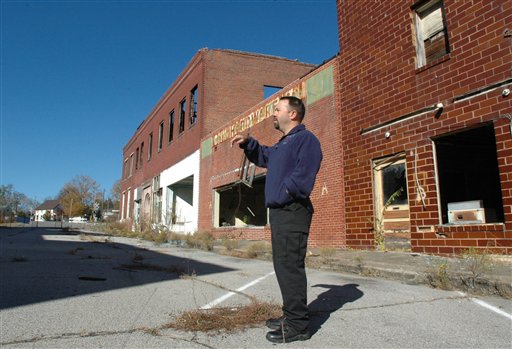(AP) Left with tornado damage, Ala town blaming FEMA
By JAY REEVES
Associated Press
CORDOVA, Ala.
Main Street in this old mill town looks about the same as it did the day after tornadoes killed about 250 people across Alabama a year and a half ago: Battered red bricks and broken glass litter the pavement, and the buildings still standing are rickety and roofless.
The entire one-block downtown, still deemed unsafe, remains sealed off by a chain-link fence. City officials blame the Federal Emergency Management Agency, saying the money to demolish skeletons of the old buildings is mired in miles of red tape.
When one request for photos or historical documentation is met, FEMA makes another, the mayor and others in this town of 2,100 say. One crop of workers is replaced by another, forcing locals to constantly explain their problems to new people.
On April 27, 2011, dozens of tornadoes ripped across the southeast, spawned by freakish weather. Hundreds were killed and thousands of homes and businesses were damaged or destroyed, causing more than $1 billion in damage.
While cleanup and demolition projects are moving along in devastated communities like Tuscaloosa and Hackleburg _ where wrecked homes and businesses are mostly gone and new ones are slowly being built _ Cordova’s downtown stands out as an eerie reminder of the destruction.
FEMA officials say they’re only doing their job in Cordova, documenting damaged buildings and covering all the details before providing money to tear them down.
Yet the process has been baffling not just for local residents but to the head of historic preservation for the state, Elizabeth Brown.
Brown said the demolition process seems to be taking longer than usual in Cordova, but government rules don’t set out a strict timetable for such decisions since needs and damage can vary so greatly from one place to another. Town leaders say FEMA has never given them a firm timetable.
Located in coal country about 35 miles northwest of Birmingham, Cordova began in the 1880s at a spot where two railroad lines converged. A textile mill operated in town for about seven decades before closing in 1962.
The mill’s failure displaced 800 workers and sent Cordova into a tailspin. Most of the 19 or so buildings in the downtown block were vacant and deteriorating by the time the twisters struck last year.
Many people left town for work in metro Birmingham or nearby Jasper before the twisters, and there are even fewer jobs in Cordova now aside from schools, a bank, a pharmacy and a health clinic. The town’s sole grocery store was wiped out and has yet to reopen; a convenience store near the battered downtown block has closed, too.
Cordova Fire Chief Dean Harbison, who also serves as the town’s recovery coordinator, said FEMA was helpful at first.
A long-term plan sponsored by FEMA initially recommended reclaiming downtown Cordova, but Haribson said an in-depth examination revealed major structural problems and city officials decided to demolish the entire block.
The mix of privately and publicly owned buildings with shared walls and varying amounts of damage proved confusing.
Town leaders didn’t anticipate historical considerations being the main roadblock to demolition because the damaged buildings weren’t on state or national historic registers, but FEMA started asking for photos and reports documenting the buildings’ past and architecture, Harbison said.
After two rounds of requests and a conference call, FEMA finally sent its own photographer to document what’s left of the city on Oct. 29, he said.
It’s hard to come or go from the town without driving past the decimated area, and the mayor said the sight is a mental barrier to moving the city forward. Three fires have burned in the damaged area since the tornadoes _ one accidental, two suspected arsons, including one in which two people were charged _ and the blazes further weakened structures blasted by the twisters.
Gilbert said the rickety buildings stand in an area that could become a home for new businesses now that a new four-lane highway linking Birmingham and Memphis, Tenn., runs just a few miles from the city, but that can’t happen until the old ones are demolished. The struggling city can’t afford the estimated $933,000 cost of demolishing the structures, he said, so it’s counting on FEMA to fill the gap.
FEMA spokesman Danon Lucas said that’s not true.
No other Alabama city has had the same problem since the twisters, Brown said. While it took about a year to approve the demolition of the high school in the northwest Alabama town of Phil Campbell because of historical considerations, Cordova is in a league of its own, she said.

COMMENTS
Please let us know if you're having issues with commenting.